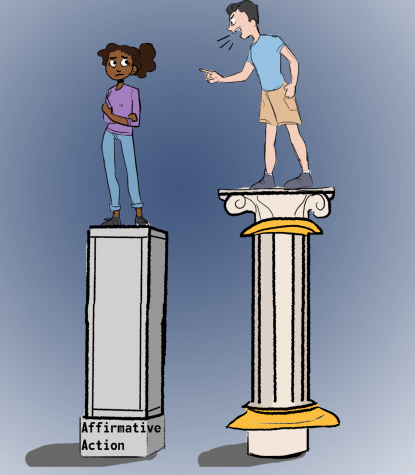The Case for Affirmative Action
How Affirmative Action Helps End Systemic Oppression of Minorities
As a disclaimer, I am writing this as someone with a Middle Eastern heritage, so I check the race box “white.” That is a different story for a different day.
The crusade against Affirmative Action is led by a conservative activist, Ed Blum. He has been suing schools for years on the idea that they are not admitting deserving White/Asian students due to “racial quotas” and “racial balancing.” These two ideas appear frequently when discussing affirmative action, but they do not depict the reality. In fact, in the 1978 Regents of University of California v. Bakke case, the Supreme Court declared it impermissible for schools to use racial quotas and racial balancing in their admission process; instead, colleges are encouraged to be “race-conscious” in their “holistic” admissions process. This means that colleges must look at each applicant as a whole beyond their test scores, and race is one factor in a myriad of others that colleges consider.
This holistic admissions process is justified. The goal of each college is to help students make great contributions to the world, and, hopefully, later to the alumni donation funds. So, the college must produce successful students, and test scores alone don’t allow them to do this.
According to the Washington Post, studies conclude that more than 80% of the variance success is due to factors beyond test scores, like grit, perseverance, character, “learning ability,” etc. It doesn’t matter if a student is building a company or a bridge, being able to regurgitate the same SAT vocabulary words will get them, literally, nowhere. The insignificance of standardized testing also proves why it is really bad to call students of lower scores “unqualified.” Everyone is qualified in their own ways, and colleges know this. If colleges really want a successful class, they must choose candidates with talents beyond taking standardized testing.
Furthermore, if all the students in a college had the same background and point of view, there wo uld be an echochamber effect of the same ideas. It is ultimately a diversity in opinions that leads to progress and success.
uld be an echochamber effect of the same ideas. It is ultimately a diversity in opinions that leads to progress and success.
If you are never conscious of your race or feel it doesn’t affect how your world works, congratulations, you have privilege. But, don’t assume that for others. White people deciding that they don’t need to see the race of others because it might put them at a slight disadvantage might be as ironic as The Scarlet Letter.
Race blind policies don’t acknowledge the racial identity of others, and the struggles of millions of students still battle due to centuries of systemic racism. African American teenagers walk around unarmed with the fear of being shot by a police officer because of their skin color. Female Muslim teenagers walk around afraid they will be the target of a hate crime because they wear a scarf on their head that represents the most hated religion in America (and Middle Eastern students still don’t benefit from Affirmative Action!). Being a student of color in America is difficult because you are dealing with the normal challenges as a teenager, and you are also trying to find your place in an America that continues to favor white people. If you deny students the right to be proud of their identity, then you refuse to acknowledge their struggle. And, as I have established earlier, it is how students overcome their struggles that ultimately leads to success.
So what happens to underrepresented minorities when you take away affirmative action? In 1996, Proposition 209 forced the UC system to have race-blind admissions. According to University of California, there was a 30 percent admission rate drop from 1997 to 1998 for African Americans and LatinX applicants at UC Berkeley. In 2013, according to the National Center for Education Statistics, while LatinX students represented 47 percent of California high school graduates, they made up 17 percent of UC Berkeley enrollees. Considering that 22% of African Americans and 20% of Hispanics are below the federal poverty line (US Census), the reduced availability of education continues a cycle of poverty for people of color.
By contrast, Harvard, which has affirmative action policies, has a class that is a little bit more representative of the US population. According to the Census and Harvard, Hispanics make up 18.1% of the population and 12.3% of the admitted class. These numbers are not perfect, but they are better than the UC system.
I think it is clear why it is so important for schools to have affirmative action for underrepresented minorities. But now, let’s talk about those who must incur a “penalty” for their race.
For Asian Americans, they actually benefit from Affirmative Action. Original Affirmative Action causes provided bilingual education to Asian Americans who were denied the right of education. In 2016, a national poll by Asian Americans Advancing Justice, found that 64 percent of Asian American voters favor Affirmative Action. If anything, the Harvard lawsuit is a white person, Ed Blum, using Asian Americans to further his personal vendetta. Furthermore, while Asian Americans make up 5% of the US population, they make up 22.9% of Harvard’s class of 2022. This is really important for Asian Americans because, after the UC System instituted “race-blind policies,” admission rates for Asian Americans dropped by 16.3% and 32% from 1998 to 2009 at UC Berkeley and UCLA respectively according to the National Commission on Asian American and Pacific Islander Research in Education. Not only do race blind admissions negatively affect admissions rates for Asian Americans, but also it would create precedent for the elimination of diversity initiatives in the workplace, where Asian Americans continue to face discrimination and are ranked the least likely to be promoted, according to Harvard Business Review.
For white people, affirmative action isn’t the problem; it is legacy admissions. Legacy admissions are an example of unearned advantage, the very definition of privilege. According to CNBC, Harvard’s class of 2021 is over 29% legacy students, which means there are more legacy students than students of underrepresented minorities.
This doesn’t stop at Harvard; in fact, according to Washington Post, for the top 30 schools, children of alumni have a 45% greater chance of admission. The Crimson also corroborates that 21.5% of legacy students are white, while for African American, Hispanic, and Asian student the figures are around 4-6%. This is notable because 18% of legacy students are actually below the academic range of the average applicant. However, this doesn’t occur for students who benefit from Affirmative Action.
In the iconic Affirmative Action case, Fisher v University of Texas led by the same Ed Blum, according to Washington Post, 42 of the 47 students with lower scores than Fisher that were admitted were white. The case also forgets to mention that 168 African American and Hispanic students with better scores than Fisher’s were also denied, and they didn’t bring a case to the Supreme Court. Furthermore, when the UC system opted for race blind policies, white student acceptance rate at Berkeley only rose by 2 percent, according to the University of California.
So, you must ask yourself: is that 2% really worth fighting for when the systematic oppression of minorities will only continue as they will be denied the right to an education and an identity?




